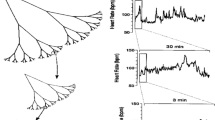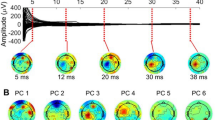Abstract
Electrocardiographic (ECG) signals are affected by several kinds of artifacts that may hide vital signs of interest. In this study we apply independent component analysis (ICA) to isolate motion artifacts. Standard or instantaneous ICA, which is currently the most addressed ICA model within the context of artifact removal, is compared to two other ICA techniques. The first technique is a frequency domain approach to convolutive mixture separation. The second is based on temporally constrained ICA, which enables the estimation of only one component close to a particular reference signal. Performance indexes evaluate ECG complex enhancement and relevant heart rate errors. Our results show that both convolutive and constrained ICA implementations perform better than standard ICA, thus opening up a new field of application for these two methods. Moreover, statistical analysis reveals that constrained ICA and convolutive ICA do not significantly differ concerning heart rate estimation, even though the latter overcomes the former in ECG morphology recovery.








Similar content being viewed by others
References
Anemüller J, Sejnowski TJ, Makeig S (2003) Complex independent component analysis of frequency-domain electroencephalographic data. Neural Netw 16(9):1311–1323
Anemüller J, Duann JR, Sejnowski TJ, Makeig S (2006) Spatio-temporal dynamics in fMRI recordings revealed with complex independent component analysis. Neurocomputing 69:1502–1512
Barros AK, Mansour A, Ohnishi N (1998) Removing artifacts from electrocardiographic signals using independent components analysis. Neurocomputing 22:173–186
Bronzino JD (2000) The biomedical engineering handbook, 2nd edn. CRC, LLC Boca Raton
Burbank DP, Webster JG (1978) Reducing skin potential motion artifacts by skin abrasion. Med Biol Eng Comput 16:31–38
He T, Clifford G, Tarassenko L (2006) Application of independent component analysis in removing artefacts from the electrocardiogram. Neural Comput Appl 5:105–116
Hyvärinen A, Oja E (1997) A fast fixed-point algorithm for independent component analysis. Neural Comput 9(7):1483–1492
Hyvärinen A, Karhunen J, Oja E (2001) Independent component analysis. Wiley, London
James CJ, Gibson OJ (2003) Temporally constrained ICA: an application to artifact rejection in electromagnetic brain signal analysis. IEEE Trans Biomed Eng 50(9):1108–1116
James,CJ, Hesse CW (2005) Independent component analysis for biomedical signals. Physiol Meas 26:R15–R39
Jung TP, Makeig S, Humphries C, Lee TW, McKeown MJ, Iragui V, Sejnowski TJ (2000) Removing electroencephalographic artifacts by blind source separation. Psychophysiology 37(2):163–178
Lee J, Park KL, Lee KJ (2005) Temporally constrained ICA-based foetal ecg separation. Electron Lett 41:1158–1160
Lu W, Rajapakse JC (2001) ICA with reference. In: Proceedings of 3rd international conference independent component analysis and blind signal separation: ICA 2001, pp 120–125
Makeig S, Bell AJ, Jung TP, Sejnowski TJ (1996) Independent component analysis of electroencephalographic data. Adv Neural Inf Process Syst 8:145–151
Mckeown M, Makeig S, Brown G, Jung T, Kindermann S, Bell A, Sejnowski, TJ (1998) Analysis of fMRI data by blind separation into independent spatial components. Human Brain Map 6:160–188
Milanesi M, Vanello N, Positano V, Santarelli M, Paradiso R, De Rossi D, Landini L (2005) Frequency domain approach to blind source separation in ecg monitoring by wearable system. Proc Comp Cardiol IEEE 32:767–770
Milanesi M, Vanello N, Positano V, Santarelli MF, Landini L. (2005) Separation and identification of biomedical signals based on frequency domain independent component analysis. WSEAS Trans Syst 10:1752–1761
Milanesi M, Martini N, Vanello N, Positano V, Santarelli MF, Paradiso R, De Rossi D, Landini L (2006) Multichannel techniques for motion artifacts removal from electrocardiographic signals. In: Proceedings of the 28th annual intern conference of the IEEE Eng Med and Biol Soc (EMBS), New York, USA, pp 3391–3394
Murata N, Ikeda S, Ziehe A (2001) An approach to blind source separation based on temporal structure of speech signals. Neurocomputing 41:1–24
Opie LH (2004) Heart physiology. Lippincott Williams & Wilkins, Philadelphia
Pan J, Tompkins WJ (1985) A real-time QRS detection algorithm. IEEE Trans Biomed Eng 32(3):230–236
Paradiso R, Loriga G, Taccini N (2005) A wearable health care system based on knitted integrated sensors. IEEE Trans Inf Technol Biomed 9(3):337–344
Peng C, Qian X, Ye D (2007) Electrogastrogram extraction using independent component analysis with references. Neural Comp Appl 16:581–587
Raya MAD, Sison LG (2002) Adaptive noise cancelling of motion artifact in stress ECG signals using accelerometer. In: Proceedings of 2nd joint EMBS/BMES Conference, Huston, pp 1756–1757
Rompelman O, Ros HH (1986) Coherent averaging technique: a tutorial review. Part 1: noise reduction and the equivalent filter. J Biomed Eng 8(1):30–35
Smaragdis P (1998) Blind separation of convolved mixtures in the frequency domain. Neurocomputing 22:21–34
Tam HW, Webster JG (1977) Minimizing electrode motion artifact by skin abrasion. IEEE Trans Biomed Eng 24(2):134–139
Vayá C, Rieta JJ, Sánchez C, Moratal D (2006) Performance study of convolutive BSS algorithms applied to the electrocardiogram of atrial fibrillation. In: Proceedings of 6th international conference independent component analysis and blind signal separation: ICA 2006, pp 495–502
Vanello N, Positano V, Ricciardi E, Santarelli MF, Guazzelli A, Pietrini P, Landini L (2003) Independent component analysis of fMRI data: a model based approach for artifacts separation. In: Proceedings of 1st International IEEE EMBS Conference on Neural Engineering, pp 529–532
Webster JG (1984) Reducing motion artifacts and interference in biopotential recording. IEEE Trans Biomed Eng 31(12):823–826
Author information
Authors and Affiliations
Corresponding author
Rights and permissions
About this article
Cite this article
Milanesi, M., Martini, N., Vanello, N. et al. Independent component analysis applied to the removal of motion artifacts from electrocardiographic signals. Med Biol Eng Comput 46, 251–261 (2008). https://doi.org/10.1007/s11517-007-0293-8
Received:
Accepted:
Published:
Issue Date:
DOI: https://doi.org/10.1007/s11517-007-0293-8




